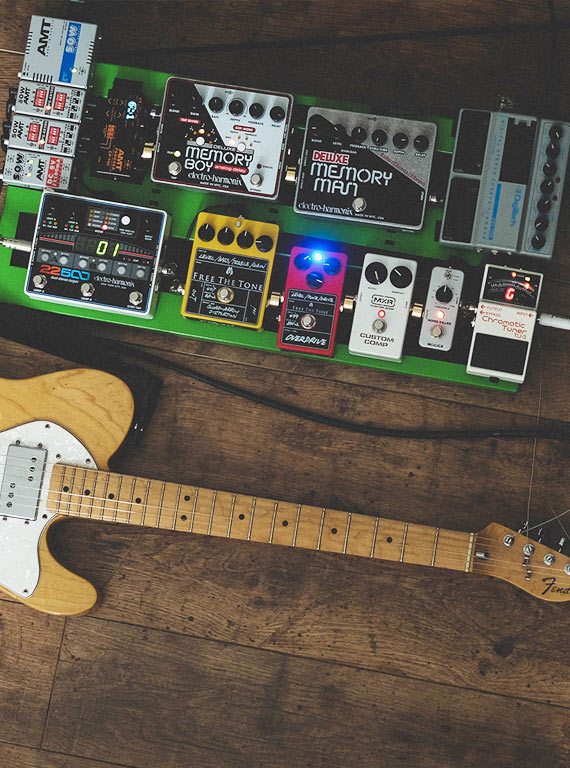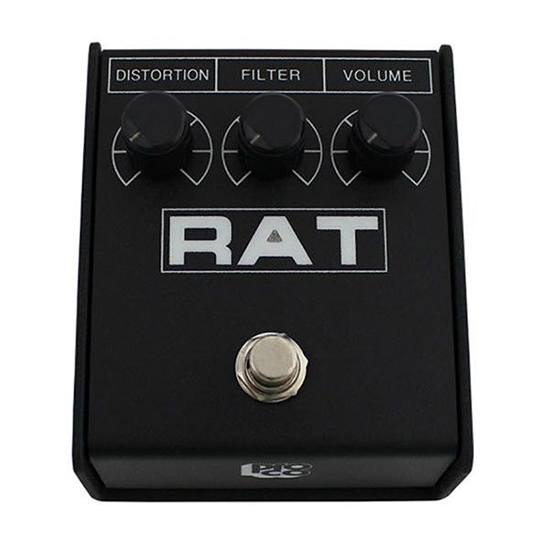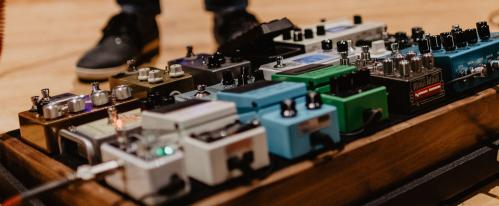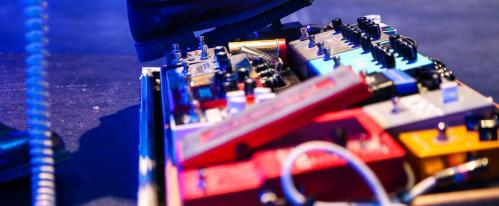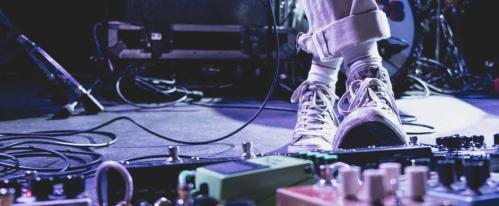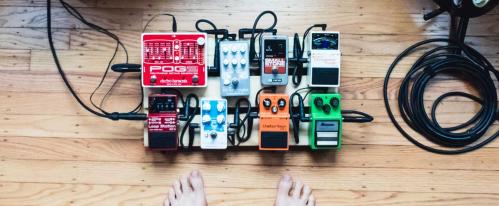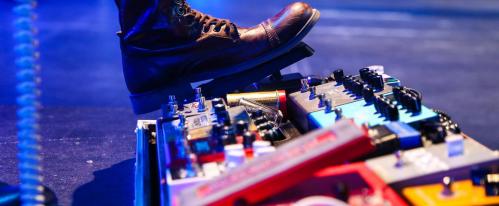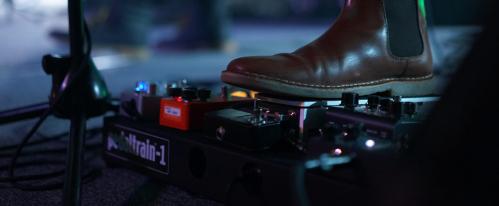WE TAKE A LOOK AT ALL THE DIFFERENCES BETWEEN OVERDRIVE, DISTORTION AND FUZZ TO HELP YOU FIGURE OUT WHICH PEDAL YOU NEED TO GET YOUR PERFECT SOUND
Even if you're a seasoned guitar pedal geek (aren't we all?) figuring out the differences between overdrive, distortion and fuzz can be a little confusing, especially if you want to get the perfect effect for your sound! So today we’re going to look at all the different types of effects, the differences in sounds and how they interact with your amplifier and guitar. We’ll also aim to show you which styles of effects might be right for you with some of the industry standard options.
OVERDRIVE VS DISTORTION VS FUZZ!
To understand the difference though, we need to look at each type of effect just in a little bit more detail. If you want the short version, just skip to the bottom of the blog - but hey, maybe stick around? You might learn something, and let's face it you never stop learning when it comes to music! Let’s take a more in depth look at each type of effect so we can figure out what the difference is between overdrive, distortion and fuzz.
WHAT IS OVERDRIVE?
Overdrive pedals can sometimes be confused with distortion pedals, but make no mistake, an overdrive is a different animal altogether. Overdrive pedals drive your valves to the point of distortion, or at the very least mimic what that would sound like if you have a solid state amplifier. The purpose of an overdrive pedal is to mimic the sound of you turning up your valve amp as loud as it can go, except this is a far safer (and neighbour-friendly) option.
It's probably the closest you can get to pure amplifier distortion without actually blowing out your windows.
Essentially, the aim of an overdrive pedal is to provide you with the same dynamics that you get when you play a cranked tube amp. The effect responds to your touch - play soft and you’ll hardly notice the gain, but dig in and listen to how your signal starts to break up. Overdrives provide a soft-clipping sound, so don’t expect earth-shattering crunch from one – it’s there to add a smooth, dynamic sound rather than melt faces.
Overdrive is definitely a "gentle" style of distortion that waits for you to play hard before it unleashes the sound you want. To get the full benefit of an overdrive, play it through a valve amplifier/tube amp as these pedals are designed to make your tubes work harder at lower volumes. Trust us, you’ll really appreciate it, especially through the likes of a VOX AC30, Fender Bassbreaker or Marshall JCM 800.
Ideal for: Blues, Rock and Country players as well as those who want a gain boost with a bit of flavor without losing the tone of their guitar or amplifier too much.
3 OVERDRIVE PEDALS WE RECOMMEND
IBANEZ TS9 TUBESCREAMER
The Tubescreamer is probably the most famous and commonly used overdrive pedal. The Ibanez TS9 Tubescreamer reissue is now considered an industry standard thanks to how easy it is to operate and how beautiful it sounds through your valve amplifier. You can add a little boost to your signal or push your valves to the point of saturated heaven!
BOSS SD1 SUPER OVERDRIVE
The Boss SD-1 Super Overdrive pedal effectively produces the warmth and natural distortion of an overdriven tube amp, responding beautifully to all the subtleties of your playing. This pedal is perfect for adding that extra drive boost to your sound without becoming overbearing.
Pro tip: Set your amp up with a touch of gain and kick this in when you need to push it a little harder for a beautiful sounding overdrive tone that retains all the beauty of your amplifier and guitar. Easy to use, built like a tank and complete with a Boss 5 year warranty - just a few reasons why this pedal is relied on by professional musicians everywhere. If you want more options, check out the Boss Waza Craft SD-1W Super Overdrive with all analogue circuitry and a more refined custom tone designed by the the engineers in Boss Japan.
Fender Santa Ana Overdrive Pedal
The Fender Santa Ana Overdrive Pedal is a newcomer to the scene of overdrive pedals and hails from the new range of fender effects pedals. These pedals have taken the music world by storm, offering exceptional tone and easy manipulation of your sounds without ever getting too difficult to operate.
This is one of the best options as you have the ability to add a Drive Boost (overdrive sound) as well as a Level Boost - it's essentially 2 pedals in 1.
You also have 2 distinct overdrive voices to choose from, making it ideal for a wide variety of players.
DESCRIBE OVERDRIVE AS A PERSON!
I think the best way to describe an Overdrive is to think of it as an amplifier sound support system. The pedal says to your amp "OK, I like the sound you've got, but I'm here to push that sound and make you work harder!" It's essentially the personal (sound) trainer of the effects world.
Want more? Check out our 15 Best Overdrive Pedals Blog Here.
WHAT IS DISTORTION?
Distortion pedals are very different to Overdrive pedals. A distortion pedal is a little more aggressive than an overdrive as it takes your tone and completely screws with it to create something entirely of its own creation. Where an overdrive simply drives your amp, or mimics that coveted cranked sound, a distortion has it's own agenda completely and changes the sound accordingly. A distortion pedal will cram a load of filth and grit into your tone - and depending on which option you choose - will either create some serious rocking crunch or all-out doom laden, earth-shattering distortion by saturating and taking over the signal completely.
With most distortion pedals, it doesn't really matter how hard or soft you play - you'll get the same effect. A distortion pedal is a hard-clipping device that is here to do one job and do it well - distort your sound! A distortion pedal is commonly associated with heavy rock bands as they give your sound a "heavy" tone, darkening the output and even boosting the signal depending on your settings. It also compresses the signal allowing you to enjoy far more sustain which will eventually break into feedback.
If you prefer the hi-gain sounds of a solid state amplifier, the all-out attack of the grunge sound or the heavier, dirtier and tighter sound of the metal world, you'll love throwing a distortion pedal through the likes of a Mesa Boogie, Blackstar or Laney amplifier.
Ideal for: Fans of Metal, Rock and the heavier genres of music. A distortion pedal is also a great idea for those who want to make their chorus lines, solos and power chords really stand out. Everyone should have a distortion pedal on their pedal board.
3 DISTORTION PEDALS WE RECOMMEND
BOSS DS-1 DISTORTION
Widely regarded as one of the best distortion pedals ever created, the Boss DS-1 was used by the likes of Kurt Cobain, Steve Vai and even Glenn Frey to get a myriad of different distortion effects and is one of the best selling Boss pedals ever.
This famous pedal provides everything from smooth distorted tones to all out heavy rock sounds at all levels. An articulate, versatile pedal that retains your dynamics, offers lush sustain and can help you achieve everything from thrash metal to grunge and everything in between. Even after 40 years in production, it's still found on pedal boards today.
MXR M104 DISTORTION PLUS GUITAR EFFECTS PEDAL
Simple yet extremely effective, the MXR M104 Distortion Plus Guitar Effects Pedal is another fantastic option for fans of lush distortion effects. Made famous by the late and great Randy Rhoads, this pedal defined an era of guitar tones. Built to MXR's impeccable standards, the MXR Distortion + can go from smooth Rock distortion to crushing riffage in an instant thanks to the super easy-to-use layout.
The Output knob controls how loud you want the effect to be, whilst the Distortion knob allows you to dictate whether you want some beautiful sounding low-level distortion for those rhythm sections - or you can crank it all the way up for some sweet lead and riff tones.
An instantly recognisable pedal that will last a lifetime.
Pro Co RAT2 Distortion Pedal
The Pro Co RAT2 Distortion Pedal is a bit of anomaly as it can not only do all three sounds - distortion, overdrive and fuzz - but it does them EXTREMELY well.
Although technically a distortion pedal, you can turn the distortion down and volume up for an overdrive sound, or turn the filter right back to get a fuzz sound. Otherwise, you should really just enjoy the fact you can go from smooth saturation to all out chugging riffs with this pedal.
This pedal has been relied upon by the Dave Grohl, Kurt Cobain, Graham Coxon, Alex Turner, David Gilmour and many more players. It takes a little getting used to and doesn't make any apologies for that, but the Pro Co Rat 2 pedal is easily one of the best distortion pedals on the planet.
DESCRIBE DISTORTION AS A PERSON!
Distortion is a little more selfish when it comes to the effect it has on an amplifier. It basically says to your amp "OK buddy, I hear what you're trying to do, but I think I can do a better job. When you ask me to get involved, it's just me. Cool?" The distortion pedal hears what you're saying and is going to do exactly what it's here to do -it will not deviate from the task at hand!
Check out our Best Distortion Pedals Blog for more.
WHAT IS FUZZ?
Where distortion pedals provide a hi-gain distorted sound, they fear to tread where fuzz pedals go. A fuzz pedal takes your sound and clips it extremely hard - known as square-wave clipping - thereby compressing the distortion to make an almost unrecognisable sound. This thing does exactly what it wants!
The fuzz pedal heavily saturates your tone and covers it in a woolly, "fuzzy" feel - there's really no better way to describe it! This type of pedal offers a huge amount of sustain by heavily processing your signal and offering a more artificial tone that is entirely its own, which some guitarists feel makes your amp sound like its broken. Fuzz pedals clip so hard that playing anything other than lead lines or single-string riffs sounds a bit weird.
However when you decide to bust out a power chord or huge riff, the amount of power behind them is astonishing. Think about Smashing Pumpkins 'Cherub Rock' which made use of the EHX Big Muff and you'll get the idea, or The Stooges 'I Wanna be Your Dog' to give you an idea of how interesting (and iconic) a fuzz pedal can be.
If you turn a guitar amp up loud you'll get the sound of an overdrive, if you turn it up full whack you'll get distortion - fuzz is the sound of an amp pushed past its maximum into completely unnatural territory and it sounds great! Jimi Hendrix was perhaps the most famous fuzz pedal player of all time championing the likes of the Fuzz Face. Couple it with a Wah Pedal and you'll instantly recognise the sound.
Ideal for: Fans of Grunge, Post-Punk, QOTSA, Hendrix-style tones, big riffs and those who want to add an element of unpredictability to their tone.
3 FUZZ PEDALS WE RECOMMEND
ELECTRO-HARMONIX BIG MUFF PI USA NYC FUZZ PEDAL
In the world of Fuzz pedals, there are a select few that have had such a profound effect on music that they have become synonymous with entire genres of music and in the process creating a signature sound for many artists.
The Electro-Harmonix Big Muff Pi USA NYC Fuzz Pedal is one of these pedals. If you like the sound of Mudhoney, 'Siamese Dream'-era Smashing Pumpkins or more recently, Jack White's guitar tone - you'll love a Big Muff. This thing is a classic fuzz pedal that is equipped with three easy to use knobs that allow you to adjust the volume of the effect, the tone and the sustain whilst you enjoy one of the most famous pedals of all time. Every board should have one of these things.
Dunlop FFM2 Fuzz Face Mini Germanium Guitar Pedal
If you fell in love with the sound of Jimi Hendrix, you're probably already in love with the Fuzz Face without even knowing it. Although Hendrix used the now out of production Dallas-Arbiter Fuzz Face, you can still achieve those lush "Are You Experienced" fuzz tones. The Dunlop FFM2 Fuzz Face Mini Germanium Guitar Pedal has been constructed to the exact specifications of the original Dallas-Arbiter Fuzz Face to reproduce that classic Hendrix sound.
This pedal uses the original Germanium PNP transistor design and vintage specs to provide you with that retro fuzz sound that Hendrix fans covet. Whether you want the wind to Cry Mary, you want to make a slight return to Voodoo Chile or you're in the mood for some Purple Haze - this pedal will get you there.
Although the original pedal is about the size of a small dinner plate, this is a more pedal board friendly option, which provides the same tone as the classic in a much smaller chassis. Honourable mention goes to the Dunlop Jimi Hendrix Fuzz Face Pedal that has been created with the same specifications as the last two pedals, with modern improvements such as an LED status, true bypass switching and MXR pedal-sized enclosure, not to mention some amazing Hendrix art by legendary rock artist Gered Mankowitz!
FENDER THE PELT FUZZ PEDAL
The new range of Fender effects pedals have completely blown us away here at PMT. These hard working, great sounding FX pedals have taken the music world by storm thanks to their no-fuss controls, solid construction and great looking design. Oh, and they sound absolutely IMMENSE too! Fender's The Pelt Fuzz really solidifies its spot as one of the best fuzz pedals on the market today thanks to its lush sound that can go from biting, spitting fuzz to creamy fuzz-filled distortion that blurs the boundaries between the two sounds.
We love the fact you have a Mid-switch that can boost or cut your midrange, as well as a Thick-switch that provides loads of extra girth when needed. Another key feature comes in the form of the Bloom setting that allows you to sculpt how much the fuzz blends in to the overall sound and how it responds to the dynamics of your playing. So much feel in a fuzz pedal!
DESCRIBE FUZZ AS A PERSON!
Fuzz is a completely different beast altogether. It's all or nothing with Fuzz. It's the opinionated, moody roommate that is predictably unpredictable. It basically says to your amp "I don't care about you or your sound. Seriously mate, when I get involved I'm gonna do whatever I want and I don't care what you think."
SERIOUSLY, CAN YOU JUST TELL ME WHAT THE DIFFERENCE BETWEEN OVERDRIVE, DISTORTION & FUZZ IS, PLEASE?
Ok, ok! In summary:
Overdrive pedals either provide a gain boost and “overdrive” your valves within your tube amp, or mimic the effect of the valves within a tube amp distorting. The dynamic is far more sensitive. The harder you play the more it distorts.
Distortion adds a consistent crunch or grit to what you’re playing. Whereas an overdrive takes your original tone and pushes it harder, a distortion pedal changes the sound completely and saturates the signal. You get the same amount of distortion no matter how hard or soft you play.
Fuzz is a more aggressive style of compressed distortion. It achieves the sound by heavily saturating and clipping your signal. Fuzz alters the waveform into a square wave and can almost makes your amp sound like it’s broken.
So now go out there and find the best sound for you. Pit Overdrive vs Distortion vs Fuzz and create your very own style of music. Enjoy!

